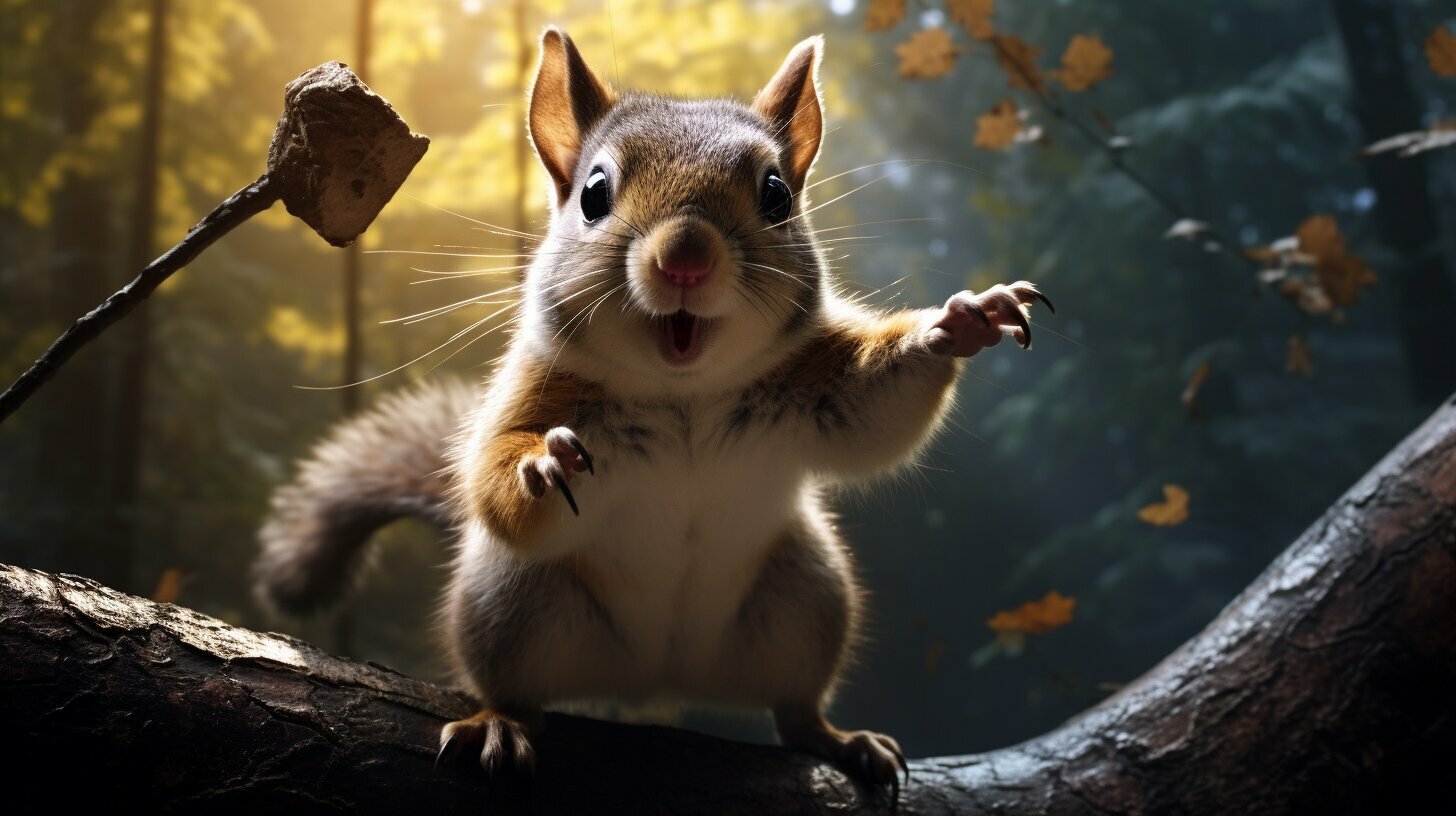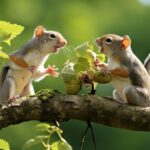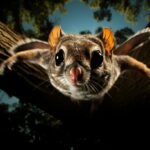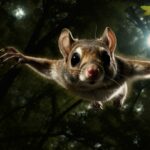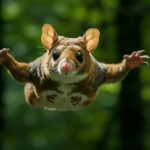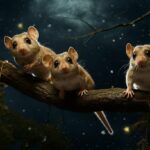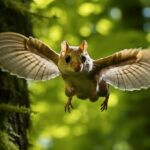Flying squirrels have a diverse and fascinating diet that supports their active lifestyle and nocturnal habits. These captivating creatures do not actually fly but glide using skin flaps, and they have evolved unique adaptations for survival in their treetop habitats.
With their dark backs and light undersides, flying squirrels sport long bushy tails and possess continuously growing teeth that they gnaw to grind down. They are efficient feeders, using their sharp teeth to make small holes in nuts and acorns, extracting the nutritious contents within.
Unlike other squirrel species, flying squirrels do not build their own nests. Instead, they repurpose abandoned woodpecker hollows as their cozy homes. Being nocturnal creatures, they are most active during the night, foraging for food to sustain their energy levels.
When it comes to their diet, flying squirrels are both omnivorous and opportunistic, consuming a variety of foods. They primarily rely on nuts, such as acorns, hickory nuts, and walnuts, which serve as a primary source of energy. Fruits, eggs, and fungi also play a crucial role in their nutritional intake, providing essential vitamins and minerals.
However, flying squirrels have a few surprising food choices too! They enjoy indulging in cheese, vegetables, eggs, and even pet food. These unexpected food options further diversify their diet and add new flavors to their palate.
Calcium and other dietary supplements are crucial in meeting the special dietary requirements of flying squirrels. These supplements ensure their overall health and well-being. Regular veterinary check-ups are also essential to monitor their health and address any potential issues.
Unfortunately, flying squirrels face threats due to deforestation and habitat fragmentation caused by human activities. These factors can disrupt their food sources and natural habitat, affecting their survival.
For those considering keeping flying squirrels as pets, their dietary requirements need to be carefully considered. A balanced and varied diet, along with a spacious cage equipped with hiding places and soft nesting material, is essential for their well-being. Flying squirrels are social animals that reproduce in tree hollows and become independent at around two to three months old.
Key Takeaways:
- Flying squirrels have a diverse diet that includes nuts, fruits, eggs, fungi, and even surprising foods like cheese and vegetables.
- Calcium and dietary supplements are important for their health and well-being.
- Deforestation and habitat fragmentation pose serious threats to flying squirrel populations.
- When kept as pets, flying squirrels require a varied diet and a spacious cage with hiding places.
- They are social animals that reproduce in tree hollows and become independent at two to three months of age.
Understanding the Natural Diet of Flying Squirrels
In their natural habitat, flying squirrels consume a variety of foods that provide them with the necessary nutrients for survival. These fascinating creatures have evolved to adapt to their surroundings, making the most of the food sources available to them. Their diet consists of nuts, fruits, eggs, and fungi, which offer a balance of proteins, carbohydrates, and essential vitamins and minerals.
One of the primary food sources for flying squirrels is nuts. They have specially adapted teeth that allow them to gnaw small holes in nuts and acorns, extracting the nutritious contents. Nuts provide an abundant source of energy, helping these agile creatures remain energetic and nimble as they glide through the treetops. Some of the nuts commonly consumed by flying squirrels include acorns, hickory nuts, and walnuts.
In addition to nuts, flying squirrels also incorporate fruits and fungi into their diet. Fruits such as berries, apples, and grapes offer a variety of flavors and vital nutrients. Fungi, including mushrooms and truffles, provide a rich source of vitamins and minerals. These additions to their diet not only add variety but also contribute to the overall health and well-being of these captivating animals.
| Food Source | Nutritional Benefits |
|---|---|
| Nuts | Rich in energy and essential fats |
| Fruits | Provide vitamins, antioxidants, and fiber |
| Fungi | Contains essential minerals and immune-boosting properties |
Surprisingly, flying squirrels have been known to enjoy an assortment of unexpected foods. They have been observed consuming cheese, vegetables, eggs, and even pet food. However, it’s important to note that these should be given as occasional treats rather than staples in their diet. A balanced and varied diet is crucial for their overall health and well-being.
To meet their specific dietary requirements, flying squirrels may need calcium and other dietary supplements. These supplements help support their bone health and overall physiological functions. It’s essential to consult with a veterinarian experienced in exotic animal care to ensure the optimal diet and supplement regime for your pet flying squirrel.
Nuts: A Primary Source of Energy for Flying Squirrels
Nuts, such as acorns and hazelnuts, are a primary food source for flying squirrels, offering them high levels of energy and essential fats. These small, agile creatures have a remarkable ability to gnaw through nuts, creating small holes to extract the nutritious kernels inside. This feeding behavior allows them to obtain the necessary sustenance for their active lifestyle and gliding abilities.
Not only do nuts provide flying squirrels with an abundance of energy, but they also serve as a valuable source of essential nutrients. Rich in proteins, vitamins, and minerals, nuts contribute to a balanced diet that supports the overall health and well-being of these captivating creatures. With their continuously growing teeth, flying squirrels are able to effectively gnaw through the hard shells of nuts, accessing the vital nutrients within.
To ensure optimal nutrition, it is recommended to offer a variety of nuts to flying squirrels. This diversity in their diet helps prevent monotony and allows for a wider range of essential nutrients to be consumed. Some suitable nuts for flying squirrels include walnuts, pecans, and almonds. It’s important to note that peanuts should be avoided, as they can cause health issues in these animals. Providing a mix of different nuts will help mimic the variety of foods they encounter in their natural habitat.
| Type of Nut | Nutritional Benefits |
|---|---|
| Acorns | High in carbohydrates, fats, and protein |
| Hazelnuts | Rich in vitamin E, healthy fats, and dietary fiber |
| Walnuts | Good source of omega-3 fatty acids and antioxidants |
| Pecans | High in monounsaturated fats and antioxidants |
| Almonds | Provide calcium, vitamin E, and healthy fats |
In conclusion, nuts play a vital role in the diet of flying squirrels, serving as a primary source of energy and essential nutrients. By offering a diverse range of nuts, you can ensure that these captivating creatures receive a balanced diet that supports their well-being. Remember to avoid peanuts and provide a variety of nuts, such as acorns, hazelnuts, walnuts, pecans, and almonds, to meet their nutritional needs and help them thrive in their natural habitat or as beloved pets.
Fruits and Fungi: Adding Variety to the Flying Squirrel Diet
Flying squirrels have a penchant for fruits and fungi, which add nutritional diversity to their diet and cater to their foraging instincts. These small and agile creatures rely on their ability to glide through the treetops in search of these delectable treats. When it comes to fruits, flying squirrels favor a wide range of options, including berries, apples, pears, and even citrus fruits.
To make the most of their fruity finds, flying squirrels have developed a clever technique. They will nibble a small hole in the fruit, allowing the juice to flow out, which they lap up with their tongues. This allows them to enjoy the nourishing benefits of the fruit without carrying the excess weight of the whole fruit back to their nests.
In addition to fruits, flying squirrels also have a taste for fungi. Mushrooms and other types of fungi provide essential nutrients and minerals that contribute to their overall health. These tiny creatures excel at sniffing out mushrooms and can locate them even when they are hidden beneath layers of leaves and soil.
Foraging for Food: A Delicate Balancing Act
For flying squirrels, finding food is not always an easy task. They must carefully navigate the forest canopy, relying on their sharp senses to locate the fruits and fungi they desire. Once they find their target, they use their nimble paws and dexterous fingers to gather the food and transport it back to their nests.
Flying squirrels are known to have a remarkable memory, which helps them remember the locations of various food sources. This skill ensures that they can return to the same trees and areas where they found a bountiful harvest in the past. By maintaining a diverse diet that includes fruits and fungi, flying squirrels can adapt to changes in their environment and ensure they always have a source of nourishment.
| Fruits | Fungi |
|---|---|
| Berries | Edible mushrooms |
| Apples | Truffles |
| Pears | Bracket fungi |
| Citrus fruits | Chanterelles |
As we continue to explore the fascinating world of flying squirrels, we discover how their diet reflects their unique adaptations and resourceful nature. From nuts to fruits and fungi, these creatures have mastered the art of sourcing food in their natural habitats. Join us in the next section as we uncover more surprising foods that flying squirrels enjoy.
Surprising Foods for Flying Squirrels: Cheese, Vegetables, and More!
While nuts and fruits form the core of their diet, flying squirrels have been known to indulge in surprising treats, broadening their palate. These fascinating creatures have a diverse range of food preferences, which can sometimes include unconventional items that one might not associate with their usual diet. Here are some surprising foods that flying squirrels enjoy:
- Cheese: Flying squirrels have been observed nibbling on small pieces of cheese. While it should not be a staple in their diet, an occasional bite can provide them with a tasty and protein-rich treat.
- Vegetables: Despite primarily being omnivores, flying squirrels have a liking for certain vegetables. Leafy greens such as spinach or kale, as well as crunchy carrots or bell peppers, can be added to their diet to provide additional nutrients.
- Eggs: It may come as a surprise, but flying squirrels have been known to consume eggs, either in the wild or as a supplement to their captive diet. Eggs are a great source of protein and can be a nutritious addition to their menu.
- Pet Food: Occasionally, flying squirrels have been observed sneaking a nibble of pet food. While it is important to ensure that the pet food is safe for their consumption, it can provide a well-rounded meal for these curious little creatures.
It is important to note that while flying squirrels may enjoy these surprising foods, their primary dietary needs should still be met with a balanced mix of nuts, fruits, and other natural food sources. These treats should be given sparingly and in moderation, as too much of a departure from their natural diet can potentially be detrimental to their health.
Table: Recommended Surprising Foods for Flying Squirrels
| Food | Description |
|---|---|
| Cheese | A protein-rich treat that flying squirrels enjoy in small quantities. |
| Vegetables | Leafy greens and crunchy vegetables can provide additional nutrients. |
| Eggs | A source of protein that can be included as a supplement to their diet. |
| Pet Food | With caution, pet food can provide a well-rounded meal for flying squirrels. |
Remember, when feeding flying squirrels, it is always advisable to consult with experts or veterinarians to ensure that the food choices you provide are safe and nutritionally appropriate for these captivating creatures. By offering a diverse range of foods, you can contribute to their overall well-being and provide them with a varied and enjoyable diet.
Meeting Special Dietary Requirements: Calcium and Supplements
Calcium is crucial for flying squirrels, and providing them with the necessary supplements can help prevent health issues and promote strong bones. Flying squirrels have continuously growing teeth that need to be kept in check through gnawing on various food items. However, their natural diet may not always provide sufficient amounts of calcium, which is vital for their overall well-being. Calcium deficiency can lead to weakened bones, muscle problems, and even reproductive issues.
To ensure a balanced and optimal diet for flying squirrels, it is essential to supplement their meals with calcium. There are various calcium supplements available specifically designed for small mammals like flying squirrels. These supplements come in the form of powders or chewable tablets that can be easily mixed with their regular food. Consult with a veterinarian to determine the appropriate dosage for your flying squirrel based on their age, weight, and overall health.
In addition to calcium, flying squirrels may benefit from other dietary supplements to meet their nutritional needs. These supplements can include vitamin D, which aids in the absorption of calcium, as well as essential fatty acids and trace minerals. Again, it is crucial to seek guidance from a veterinarian to ensure the proper balance of supplements and prevent any potential overdose or imbalance.
| Supplement | Benefits | Dosage |
|---|---|---|
| Calcium Powder | Promotes strong bones and teeth | Consult with a veterinarian |
| Vitamin D | Aids in calcium absorption | Consult with a veterinarian |
| Essential Fatty Acids | Supports overall health and immune function | Consult with a veterinarian |
| Trace Minerals | Provides vital micronutrients | Consult with a veterinarian |
Remember, flying squirrels have specific dietary needs, and providing them with a well-rounded and nutrient-rich diet is crucial for their long-term health and well-being. Regular veterinary check-ups can help monitor their nutritional requirements and detect any potential deficiencies or health issues early on.
Threats to Flying Squirrel Diets: Deforestation and Habitat Fragmentation
Flying squirrels are facing threats to their diet due to human-induced deforestation and the fragmentation of their natural habitats. These captivating creatures rely on a diverse range of food sources to meet their nutritional needs, but with the destruction of their forest homes, their access to these resources is becoming increasingly limited.
Deforestation, caused by human activities such as logging, agriculture, and urbanization, results in the loss of trees and vegetation that flying squirrels depend on for their food supply. As trees are cut down, the natural habitats of these small gliding mammals are destroyed, leaving them with fewer options for foraging and feeding.
Habitat fragmentation further exacerbates the challenges faced by flying squirrels. When their forested habitats are broken up into smaller, isolated patches, it becomes more difficult for these agile creatures to find enough food to sustain themselves. The reduced availability of suitable food sources can lead to malnourishment and decreased reproductive success.
To fully understand the impact of deforestation and habitat fragmentation on flying squirrel diets, conservation efforts must be implemented to protect and restore their natural habitats. By preserving forests and creating wildlife corridors that connect fragmented areas, we can ensure that these fascinating creatures have access to the diverse food sources they need to thrive.
Keeping Flying Squirrels as Pets: Feeding and Care
If you choose to keep a flying squirrel as a pet, it’s important to provide them with a well-rounded diet and ensure their overall well-being. Flying squirrels have specific dietary needs that you must meet to keep them healthy and happy. Along with their natural diet of nuts, fruits, and fungi, there are a few surprising foods that you can also offer them.
One of the key elements of a flying squirrel’s diet is a variety of nuts. These can include walnuts, hazelnuts, and almonds, which provide essential fats and proteins. Additionally, you can offer them fruits like apples, grapes, and bananas, which provide important vitamins and minerals. It’s also worth considering adding some vegetables to their diet, such as carrots and leafy greens, to ensure they receive a balanced nutritional intake.
While it may come as a surprise, flying squirrels can also enjoy small amounts of cheese and eggs. These can be offered as occasional treats, but should not be the main part of their diet. Pet food can also be given in moderation, but it’s essential to choose high-quality brands that are specifically formulated for small rodents.
Table: Sample Diet for a Pet Flying Squirrel
| Food Group | Examples |
|---|---|
| Nuts | Walnuts, hazelnuts, almonds |
| Fruits | Apples, grapes, bananas |
| Vegetables | Carrots, leafy greens |
| Occasional Treats | Cheese, eggs |
| Pet Food | High-quality brands for small rodents |
In addition to providing a well-rounded diet, it’s crucial to ensure your pet flying squirrel has a suitable living environment. They need a spacious cage with plenty of room to climb and glide, as well as hiding places and soft nesting material for comfort. These highly social animals also benefit from having a companion, so consider getting more than one flying squirrel if possible.
If you choose to keep a flying squirrel as a pet, remember to consult with a veterinarian who specializes in exotic pets. They can guide you on the specific dietary requirements, as well as provide regular check-ups and any necessary supplements. By providing a nutritious diet and a stimulating environment, you can ensure your pet flying squirrel thrives and remains healthy for years to come.Conclusion
The remarkable flying squirrel diet reflects their incredible ability to adapt and find nourishment in a variety of foods, making them truly fascinating creatures. These agile gliders have evolved for survival, utilizing their continuously growing teeth to gnaw through nuts and acorns, extracting the nourishing contents within. They rely on a diverse range of food sources to meet their nutritional needs, including nuts, fruits, eggs, fungi, and even surprising choices like cheese, vegetables, and pet food.
While their natural habitat is threatened by deforestation and habitat fragmentation, it is possible to keep flying squirrels as pets with the right care and attention. These social animals require large cages with hiding places and soft nesting material. It’s important to provide them with a varied diet that mimics their natural food sources, and calcium supplements are essential for their overall health. Regular veterinary checkups are necessary to ensure their well-being.
Whether in the wild or as pets, flying squirrels spend a significant amount of time collecting food for winter. Red squirrels and greys have different preferences for seeds and nuts, showcasing their individual tastes and dietary preferences. Their ability to find nourishment in a wide variety of foods highlights their adaptability and resourcefulness.
Overall, the flying squirrel diet is diverse and adaptable, allowing these captivating creatures to thrive in their natural habitat and even as pets with proper care and nutrition. Their unique feeding habits and varied food choices make them a truly remarkable species to study and appreciate.
Do Koalas Have a Varied Diet or Do They Only Eat Eucalyptus Leaves?
Koalas’ main diet: eucalyptus leaves. These furry marsupials primarily consume eucalyptus leaves, which provide them with the necessary moisture and nutrients. While eucalyptus leaves comprise most of their diet, they occasionally feed on other vegetation like bark, flowers, and stems. However, the bulk of their sustenance comes from their favored eucalyptus foliage.
FAQ
Q: What do flying squirrels eat?
A: Flying squirrels have a diverse diet that includes nuts, fruits, eggs, fungi, and even pet food.
Q: Do flying squirrels eat cheese?
A: Yes, flying squirrels can enjoy cheese as part of their diet. It provides them with additional protein and fats.
Q: Can flying squirrels eat vegetables?
A: Absolutely! Flying squirrels can eat a variety of vegetables, including leafy greens and root vegetables.
Q: Do flying squirrels need calcium supplements?
A: Yes, calcium supplements are important for flying squirrels’ health. They help promote strong bones and teeth.
Q: What are the best foods for flying squirrels?
A: The best foods for flying squirrels include nuts, fruits, vegetables, cheese, and protein-rich pet food.
Q: How often should flying squirrels be taken to the vet?
A: Flying squirrels should have regular veterinary checkups to ensure they are in good health and to address any potential issues.
Q: Are flying squirrels threatened by habitat loss?
A: Yes, deforestation and habitat fragmentation are major threats to flying squirrels, impacting their food sources and overall survival.
Q: Can flying squirrels be kept as pets?
A: Yes, flying squirrels can be kept as pets with appropriate care. They require a varied diet and large cages with hiding places and soft nesting material.
Q: How long until flying squirrels become independent?
A: Flying squirrels become independent at around two to three months of age when they are capable of finding their own food and shelter.

